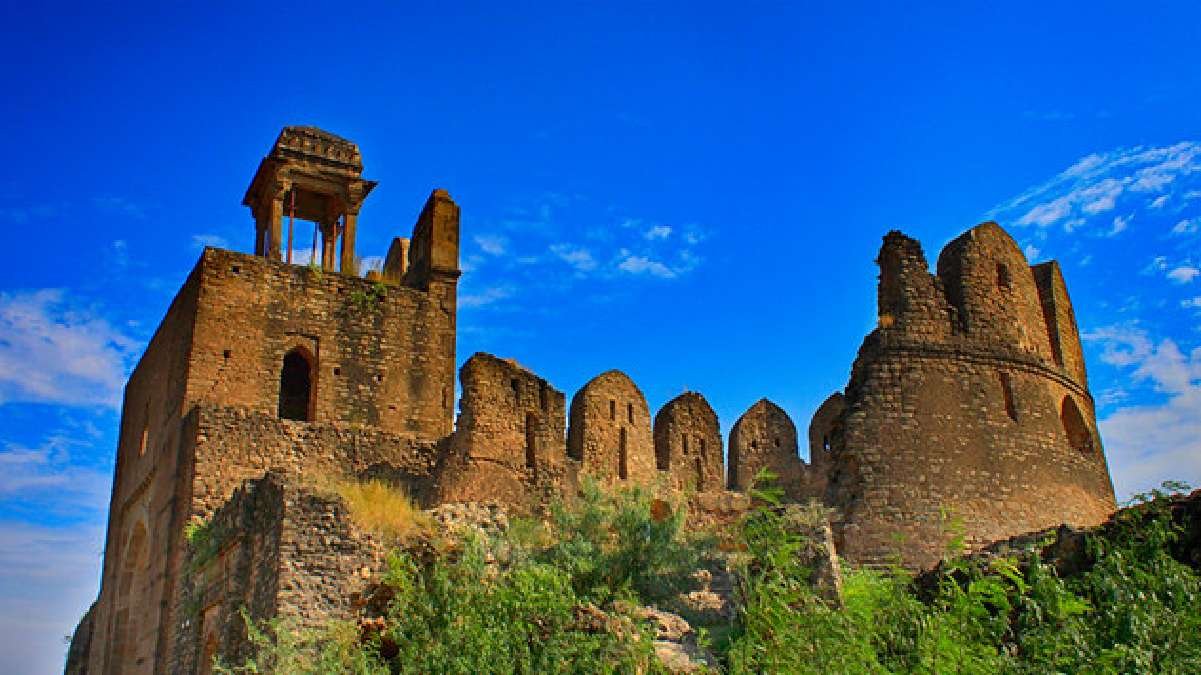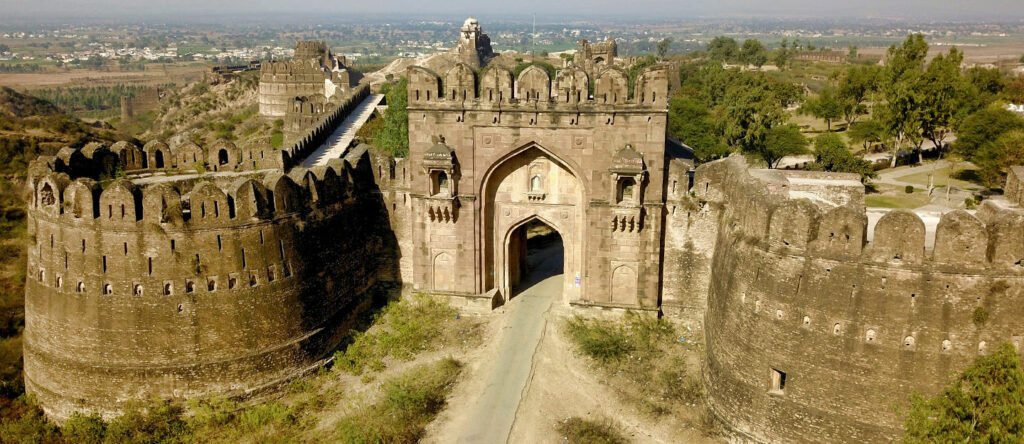
Rohtas Fort is a majestic and historically significant military fortress located near the city of Jhelum in the Punjab province of Pakistan. Constructed in the 16th century by the Afghan king Sher Shah Suri, the fort was designed to serve as a strategic stronghold and administrative centre. The fort’s architecture is a blend of Afghan and Persian influences, featuring massive walls, imposing gates, and intricate decorative elements. Covering an area of approximately 70 hectares, Rohtas Fort stands as one of the largest and most formidable fortifications in South Asia.
Table of Contents
ToggleRohtas Fort History

Origins and the Founding of Rohtas Fort
Rohtas Fort was constructed by Sher Shah Suri, the founder of the Suri Empire, between 1541 and 1548. The fort was built to secure the strategic location between the mountainous regions of Afghanistan and the northern plains of the Indian subcontinent. Sher Shah Suri aimed to use the fort to suppress the local Gakhar tribes, who were loyal to the Mughal Emperor Humayun, and to serve as a stronghold against Mughal incursions.
Importance and Significance
Rohtas Fort holds immense historical, architectural, and cultural importance. As a UNESCO World Heritage Site, it is recognized for its outstanding universal value. The fort played a crucial role in the military history of the region, serving as a defensive bulwark against the Mughal emperor Humayun. Its robust construction and strategic location allowed it to control and secure the vital routes between the northern plains and the mountainous regions.
Architecturally, Rohtas Fort is a marvel of medieval engineering. Its 12 gates, including the iconic Sohail Gate, are notable for their grandeur and intricate designs. The fort’s walls, extending over 4 kilometres, incorporate bastions and battlements that demonstrate the advanced military planning and construction techniques of the time.
Culturally, Rohtas Fort is a symbol of the rich heritage of the subcontinent, reflecting the confluence of different cultures and influences. It continues to attract scholars, historians, and tourists from around the world, offering insights into the region’s past and its architectural brilliance. The fort not only represents the historical legacy of Sher Shah Suri but also serves as a testament to the enduring strength and resilience of the structures built during that era.
Historical Events and Figures Associated with the Fort

Sher Shah Suri
The mastermind behind the construction of Rohtas Fort, Sher Shah Suri, was a formidable ruler known for his administrative acumen and military strategy. His reign marked a significant period of consolidation and defence against the Mughals.
Humayun
The Mughal emperor was temporarily ousted by Sher Shah Suri. Rohtas Fort played a crucial role in preventing Humayun’s return to power during Sher Shah’s lifetime.
Post-Sher Shah Suri Era
After Sher Shah Suri’s death, the fort continued to hold military importance. It was later occupied by the Mughal Emperor Akbar, who appreciated its strategic value and used it as a base for his northern campaigns.
Architectural Evolution and Major Reconstructions
Rohtas Fort’s architecture is a blend of Persian and Afghan influences, characterized by its massive stone walls, intricate gates, and military installations. Over the centuries, the fort underwent several modifications and repairs:
Initial Construction (1541–1548)
The original structure included formidable walls, battlements, and 12 gates, designed to withstand prolonged sieges and invasions.
Mughal Period
The Mughal rulers, particularly Akbar, made minor modifications to the fort, enhancing its defences and adding to its infrastructure.
British Era
During the British colonial period, the fort saw some conservation efforts, though its military importance had diminished. The British recognized its historical value and took steps to preserve it.
Rohtas Fort Was Built In
Date and Period of Construction
Rohtas Fort was constructed between 1541 and 1548. This seven-year period marks the establishment of one of the most significant military fortifications in South Asia, reflecting the architectural and strategic ingenuity of the era.
Context of the Era During Which It Was Built
The construction of Rohtas Fort took place during the reign of Sher Shah Suri, the founder of the Suri Empire in northern India. This period was characterized by significant political upheaval and military conflict. Sher Shah Suri had recently usurped the Mughal Emperor Humayun and was consolidating his power across the Indian subcontinent.
Sher Shah Suri was known for his administrative reforms and military strategies. The fort was built as part of his broader efforts to secure his empire against both internal rebellions and external threats. The construction of Rohtas Fort was a strategic move to control the region and safeguard the Suri Empire’s northern territories.
Rohtas Fort Built on Which River
Rohtas Fort is situated near the Kahan River. The proximity to the river provided a strategic advantage and a reliable water source for the fort’s inhabitants. The river’s presence enhanced the fort’s defensive capabilities and its accessibility.
Purpose Behind Its Construction
Rohtas Fort was built with several key purposes in mind
Military Stronghold
The primary purpose of Rohtas Fort was to serve as a military stronghold. It was designed to defend against potential invasions, particularly from the Mughal forces attempting to reclaim their empire.
Suppression of Local Tribes
The fort was strategically located to suppress the local Gakhar tribes, who were loyal to the deposed Mughal emperor Humayun. By establishing a strong military presence in the region, Sher Shah Suri aimed to quell any rebellions and secure his control.
Administrative Center
Beyond its military function, Rohtas Fort also served as an administrative centre. It was intended to oversee the region, manage resources, and administer justice, thereby strengthening Sher Shah’s governance.
Symbol of Power
The fort’s imposing architecture and formidable defences were also a symbol of Sher Shah Suri’s power and authority. It was a statement of his dominance and capability as a ruler.
Rohtas Fort remains an enduring symbol of the era’s architectural brilliance and strategic military planning. Its construction marked a pivotal moment in the history of the Indian subcontinent, reflecting the complex political and military landscape of the time.
Current Status and Condition of the Fort
Rohtas Fort is currently well-preserved, thanks to various conservation efforts undertaken by both national and international organizations. It remains a popular tourist destination, attracting visitors from around the world who are interested in exploring its historical and architectural marvels.
Tourism
The fort is open to the public, with guided tours available to help visitors understand its historical context and architectural features.
Preservation Efforts
Continuous efforts are made to restore and maintain the fort’s structures, including repairing walls, gates, and inner buildings.
Cultural Events
Rohtas Fort also serves as a venue for cultural events and educational programs, promoting awareness of its historical significance and heritage. Overall, Rohtas Fort stands as a testament to the rich history and architectural brilliance of the region, offering a window into the past and a well-preserved monument for future generations to appreciate.
Rohtas Fort Information
Facts and Trivia About Rohtas Fort
Location
Rohtas Fort is situated near the city of Jhelum in the Punjab province of Pakistan.
UNESCO World Heritage Site
The fort was designated a UNESCO World Heritage Site in 1997 for its historical and architectural significance.
Size
Covering an area of approximately 70 hectares, Rohtas Fort is one of the largest and most formidable forts in South Asia.
Construction
Built between 1541 and 1548 by Sher Shah Suri, the founder of the Suri Empire.
Architectural Style
The fort’s design is a blend of Afghan and Persian architectural styles.
Defensive Features
Known for its robust defensive features, including high walls, numerous gates, and strategically placed bastions,
Cultural Impact
The fort has been featured in various documentaries and historical studies, highlighting its significance in South Asian history.
Detailed Map of Rohtas Fort
A detailed map of Rohtas Fort would typically include the fort’s extensive walls, numerous gates, key buildings, and other significant structures. The map would show the layout of the fort, highlighting the strategic placement of defensive features and residential areas.
Conclusion
Rohtas Fort is a testament to the architectural ingenuity and strategic military planning of the 16th century. Built by Sher Shah Suri, this fortification blends Afghan and Persian styles, reflecting the rich cultural heritage of the Indian subcontinent. As a UNESCO World Heritage Site, Rohtas Fort stands as one of the largest and most formidable forts in South Asia, encompassing a vast area with its impressive gates, robust walls, and intricately designed inner structures. Its significance lies not only in its historical role as a military stronghold and administrative centre but also in its enduring legacy as a symbol of the era’s architectural and engineering prowess.


